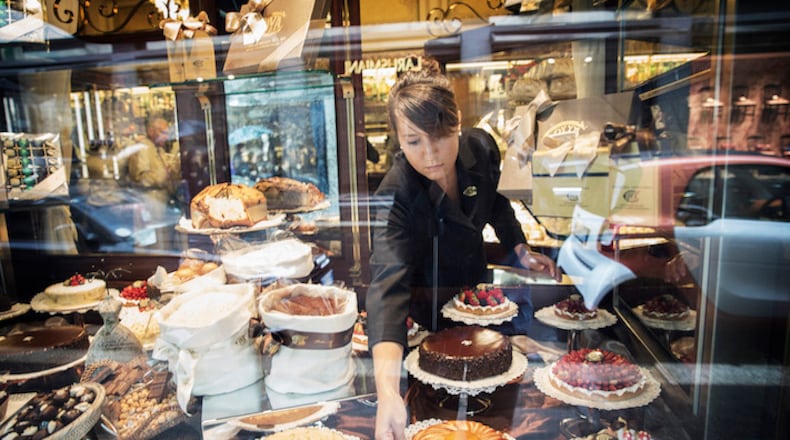There’s a new stop on this city’s style circuit.
Flanked by Versace and Omega boutiques, the new Prada-owned, Roberto Baciocchi-designed Pasticceria Marchesi cafe opened several weeks ago, just in time for fashion week, in the heart of the city’s glossiest shopping street at via Monte Napoleone, 9.
On a recent visit, upper-echelon Milanese were perusing the 38 vitrines displaying all manner of elevated tearoom fare while, outside, tourists crammed together to ogle elaborate and pricey pink Sacher tortes.
Though food and fashion have not been the coziest of bedfellows (if you wanted the second, conventional wisdom said, you had to skip the first), Prada is, in fact, not alone in uniting the two. Indeed, food — or at least pastry — has become the latest weapon in the luxury wars.
Footsteps away from Marchesi, at No. 8, is another legendary city haunt, Cova Caffè, owned by the LVMH Moët Hennessy Louis Vuitton.
The coffeehouse Sant’Ambroeus is around the corner on the Corso Matteotti; rumors have begun about luxury brands eyeing it as a potential acquisition. And Andrea Guerra, Luxottica’s former chief executive, is reportedly taking on the role of executive president of the Italian food emporium Eataly this year.
“I think this trend is going to be powerful and important,” said Luca Solca, an analyst at Exane BNP Paribas. “Consumers worldwide are expanding their notion of what luxury is, moving beyond products and into experiences. Food is a great way, like travel, to build high-quality experiences.”
It’s also a way for conglomerates to bolster their growth as the traditional luxury market stalls.
Indeed, the Marchesi and Cova flagships in the Golden Triangle are not experiments on the part of their new luxury owners, but the core of a new market grab. By adding global muscle to small, historic businesses like Cova or Marchesi (which has an Instagram handle), high-end groups can export a little bit of Italy, a fantasy destination for so many luxury-goods connoisseurs.
LVMH has 10 Cova locations in Hong Kong, the first opening in 1993, as well as in Japan and Shanghai. It plans to open two Ferruccio Laviani-designed Caffè Cova branches in Beijing in November and two in Taiwan in 2016. Further openings are being considered in Bangkok and Dubai.
Next year, the grandiose 19th-century Galleria Vittorio Emanuele II shopping arcade in Milan is to feature an additional Pasticceria Marchesi inside the new Prada quadrant, called Prada Galleria, and it is likely to offer dinner options, too. The quadrant, spanning five floors, sits in the high-traffic area opposite the original luggage store opened in 1913 by Mario Prada.
The company is evaluating plans to export the Marchesi brand to Istanbul, Hong Kong, Tokyo and Dubai, but has introduced a wide range of Marchesi merchandise, wrapped in its newly designed, sherbet-hued packaging. Think of it as the new entry point: Instead of a lipstick, you get $1 marrons glacés in liqueur.
“Fragrances used to be a younger consumer’s initial hook to a luxury brand,” said Armando Branchini, executive director of Fondazione Altagamma, a consortium of Italian luxury goods. To a certain extent, he said, “they still are, but probably food is now an appropriate hook to engage this customer.”
After all, it is portable, underscores Italian brand equity, is not too expensive, yet offers enough status back home to impress friends and colleagues.
“In terms of affordability, sipping a cappuccino at Caffè Florian in Piazza San Marco has such a high experience content, and can be afforded by a larger amount of people than buying something at Prada and Céline,” Branchini said, referring to the popular cafe in Venice.
Gaetano Marzotto, the entrepreneur and scion of the Italian textile family who in 1993 invested in the sparkling Ca’ del Bosco wine, said luxury fashion groups were finally realizing that bars and restaurants were cultural hot spots for consumers, especially in the Middle East, which places a large emphasis on “Made in Italy” food products within its luxury malls.
Stefano Cantino, Prada’s director of marketing, communication and commercial development, said, “Even though Marchesi can be considered a classic cafe, we feel this format can attract new customers.”
This is not, of course, the first time fashion has dipped its toe into the food business. In the late ‘80s and throughout the ‘90s, luxury labels tried to leverage their names by sashaying into categories like restaurants and hospitality and moonlighting as hoteliers, with mixed success.
While Giorgio Armani has a well-developed food business, with 28 outlets around the world, Dolce & Gabbana’s Gold restaurant is now in the hands of its Sicilian chef, Filippo La Mantia; the Maison Moschino, a hotel in Milan opened by the Italian label, has closed; and Hotel Missoni in Edinburgh has changed hands.
What sets the new initiatives apart from such predecessors are the decisions by Prada and LVMH to acquire free-standing companies, with ready-made histories and reputations, rather than trying to overstretch an existing brand name known for expertise in a different area.
“This time around, it’s about buying authentic heritage,” Branchini said. “It’s not something that can be created out of the blue in 48 hours.”
While industry analysts and the market may endorse the efforts of luxury stables to broaden their operations, others are not sure the trend is positive.
“Food can’t be treated in the same way as a dress,” said Oscar Farinetti, founder of Eataly.
Although Farinetti said he welcomes interest in the country’s culinary sector from high-end fashion groups, and historical landmarks like Cova and Pasticceria Marchesi deserve investment from luxury partners, he is uncomfortable with the idea of gilding the pastry.
“It should be food taking over fashion because it’s more important,” he said. “Everybody should have the luxury to eat something of high quality, and good food should be affordable to many people."
About the Author
The Latest
Featured


